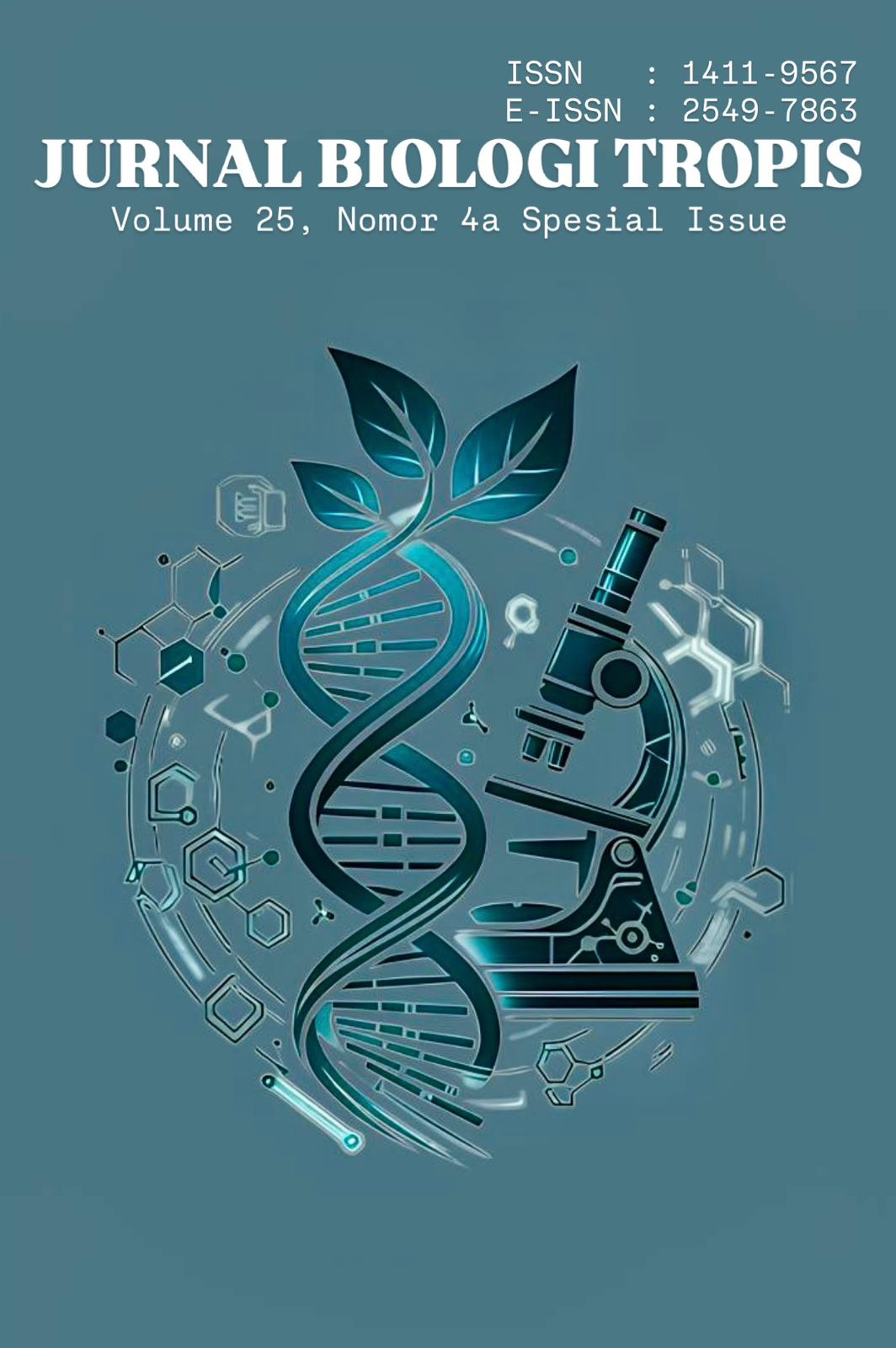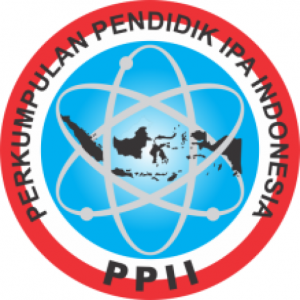Potential of Kecombrang (Etlingera elatior) Flower Ethanol Extract as an Anti-Bacterial for Escherichia coli and Pseudomonas aeruginosa in Urinary Tract Infection Patients
Authors
Angelique Fadhilah Zahra , Yusianti SilvianiDOI:
10.29303/jbt.v25i4a.10352Published:
2025-11-20Issue:
Vol. 25 No. 4a (2025): Special IssueKeywords:
Antibacterial, Etlingera elatior, Urinary Tract Infection, Escherichia coli, Pseudomonas aeruginosa.Articles
Downloads
How to Cite
Downloads
Metrics
Abstract
Pseudomonas aeruginosa and Escherichia coli are the two bacteria that produce one of the most prevalent urinary tract infections (UTIs). The rising resistance to antibiotics in these bacteria has led to the need for alternative treatments. Using natural materials, such as torch ginger flowers (Etlingera elatior), which are known to possess potent antibacterial chemicals, is one such option. This study aimed to determine the effectiveness of ethanol extract of torch ginger flower against Escherichia coli and Pseudomonas aeruginosa, and to compare its performance with ciprofloxacin as a standard control. The study was designed using a cross-sectional experimental method. The disk diffusion method on Mueller-Hinton Agar was used to assess the extract's antibacterial activity after it was made by macerating it with 70% ethanol. With an average inhibition zone of 7.8 mm against Escherichia coli and 8 mm against Pseudomonas aeruginosa at a 100% concentration, the findings demonstrated the antibacterial activity of Etlingera elatior's ethanol extract. These inhibition zones, however, were much smaller than those of ciprofloxacin, which had respective measurements of 10 mm and 34 mm. Significant differences between the extract concentrations were found by statistical analysis using the Kruskal-Wallis and Mann-Whitney tests (p < 0.05). In conclusion, the ethanol extract of torch ginger flower shows potential antibacterial activity against UTI-causing bacteria, although its effectiveness is not yet comparable to ciprofloxacin. Further research is needed to improve extraction methods and develop more effective formulations to enhance its antibacterial properties.
References
Arnaud, I., Andremont, A., Brun-Buisson, C., Coignard, B., Jarlier, V., Leclercq, R., Ploy, M. C., Quentin, C., Soussy, C. J., & Wolf, J. (2022). Antimicrobial resistance in Escherichia coli from urinary tract infections: Trends in Europe. Journal of Global Antimicrobial Resistance, 29, 156–163. https://doi.org/10.1016/j.jgar.2022.02.010
Asfar, A. M. I. A., & Asfar, A. M. I. T. (2021). Analysis of Molecular Stability on Waste Extracts of Trigona spp. Bees Haves. Ethanolically. Jurnal Bahan Alam Terbarukan, 10(2), 75–80. https://doi.org/10.15294/jbat.v10i2.33471
Aviany, H. B., & Pujiyanto, S. (2020). Analisis Efektivitas Probiotik di Dalam Produk Kecantikan sebagai Antibakteri terhadap Bakteri Staphylococcus epidermidis. Jurnal Berkala Bioteknologi, 3(2), 24–31. https://ejournal2.undip.ac.id/index.php/bb/article/view/9657
Brown, N., Buse, C., Lewis, A., Martin, D., & Nettleton, S. (2021). Pathways, practices and architectures: Containing antimicrobial resistance in the cystic fibrosis clinic. Health (United Kingdom), 25(2), 196–213. https://doi.org/10.1177/1363459319866894
Brown, N. G. F., Buse, C., Lewis, A., Martin, D., & Nettleton, S. J. (2021). Pathways, Practices and Architectures: Containing Anti-Microbial Resistance (AMR) in the Cystic Fibrosis Clinic. Health: An Interdisciplinary Journal for the Social Study of Health, Illness and Medicine, 25(2), 196–213. https://doi.org/10.1177/1363459319866894
Che Sulaiman, N., Basri, M., Fong, S. Y., & Rahman, R. N. Z. R. A. (2023). Effect of drying temperature on phytochemical content and antioxidant activity of Phaleria macrocarpa fruits. Foods, 12(15), 2859. https://doi.org/10.3390/foods12152859
Clinical and Laboratory Standards Institute (CLSI). (2023). M100 Performance Standards For Antimicrobial Susceptibility Testing, 33rd Edition,M100ed33. CLSI.
Djasfar, S., & Pradika, Y. (2023). Jurnal Medical Laboratory Identifikasi Bakteri Penyebab Infeksi Nosokomial (Pseudomonas aeruginosa) Pada Lantai Intensive Care Unit (ICU). Januari, 2(1).
Endarini, L.H. 2016. Farmakognisi dan Fitokimia. Kementerian Kesehatan Republik Indonesia.
Febia, A., Mukarlina, M., & Rahmawati, R.(2020). Aktivitas Antifungi Ekstrak Metanol Daun Bandotan (Ageratum conyzoides) Terhadap Phytophthora sp.(Im5) Secara In-Vitro. Protobiont, 9(2).
Fhitryani, S., Suryanto, D., & Karim, A. (2017). Pemeriksaan Escherichia coli, Staphylococcus aureus dan Salmonella sp. pada jamu gendong yang dijajakan di Kota Medan. BIOLINK (Jurnal Biologi Lingkungan Industri Kesehatan), 3(2), 146–155. https://doi.org/10.31289/biolink.v3i2.845
Flores-Mireles, A. L., Walker, J. N., Caparon, M., & Hultgren, S. J. (2015). Urinary tract infections: Epidemiology, mechanisms of infection and treatment options. In Nature Reviews Microbiology (Vol. 13, Issue 5, pp. 269–284). Nature Publishing Group. https://doi.org/10.1038/nrmicro3432
Foxman, B. (2014). Urinary tract infection syndromes: occurrence, recurrence, bacteriology, risk factors, and disease burden. Infectious Disease Clinics of North America, 28(1), 1-13.
Galvao, J., Davis, B., Tilley, M., Normando, E., Duchen, M. R., & Cordeiro, M. F. (2021). Unexpected low-dose toxicity of the universal solvent DMSO. FASEB Journal, 28(3), 1317–1330. https://doi.org/10.1096/fj.13-245779
Helmidanora, R., et al. (2024). Uji Aktivitas Antibakteri Ekstrak Bunga Kecombrang. Jurnal Bioteknologi.
Hooton, T. M., Gupta, K., & Stapleton, A. E. (2020). Management of urinary tract infections in adults. New England Journal of Medicine, 382(19), 1801–1812.
Indrawati, W., Hakim, R. J., Arisandi, R. F., Rahma, S., Sari, U., Studi, P., & Kimia, T. (2023). Pelatihan Pembuatan Larutan Dengan Berbagai Konsentrasi Di Pondok Pesantren Nurul Iman Parung. Jurnal
Indriana, M. (2021). Original Articel Journal Of Pharmaceutical And Sciences (Jps) Anti-Bacterial Activity Of Ethanol Extract From The Flower Of Kecombrang (Etlingera elatior jack.) In Vitro. Journal of Pharmaceutical and Sciences.
Kementrian Kesehatan Indonesia. (2017). Profil Kesehatan Indonesia Tahun 2017.
Larrauri, J. A., Rivas-García, L., Sánchez-Moreno, C., & De Ancos, B. (2022). Effect of drying temperatures on polyphenol content and antioxidant activity. Applied Sciences, 12(4), 2107. https://doi.org/10.3390/app12042107
Lister, P. D., Wolter, D. J., & Hanson, N. D. (2021). Antibacterial-resistant Pseudomonas aeruginosa: clinical impact and complex regulation of chromosomally encoded resistance mechanisms. Clinical Microbiology Reviews, 34(4), e00243-20.
Livermore, D. M. (2017). Current Epidemiology and Growing Resistance of Gram-Negative Pathogens. British Medical Journal, 56(4), 456–462.
Meyers, S., Smith, J., & Patel, R. (2020). Antibiotic Resistance in Pseudomonas aeruginosa: Challenges and Future Directions. Journal of Infectious Diseases, 221(3), 289–298. Pengabdian Kepada Masyarakat, 4(2), 371–376. http://openjournal.unpam.ac.id/index.php/JAL
Puspita, I., Qurrotul, N. A., Sumarsono, T., Andini, A., Studi D-IV Analis Kesehatan, P., Kesehatan, F., & Nahdlatul Ulama Surabaya-Jl, U. (2020). Uji Sensitivitas Escherichia coli Yang Diisolasi Dari Air Sumur Galian Dekat Dengan Septic Tank Terhadap Ciprofloxacin. National Conference for Ummah.1(1)
Puspita, S., & Wulandari, A. E. (2024). Uji Sensitivitas Escherichia coli Terhadap Ciprofloxacin. Jurnal Pengembangan Ilmu dan Praktik Kesehatan, 3. 360-Article Text-1069-2-10-20240729.
Putri, D., & Trimulyono, G. (2023). Uji daya hambat ekstrak daun pepaya (Carica papaya L.) terhadap pertumbuhan bakteri Staphylococcus aureus secara in vitro. LenteraBio: Berkala Ilmiah Biologi, 12(2), 172-178.
Raharja, H., Zubaidah, A., & Prasetyo, D. (2021). Analisis Biokimia Bakteri Kandidat Probiotik yang Berasal dari Saluran Pencernaan Udang Jerbung (Penaeus merguiensis). Acta Aquatica: Aquatic Sciences Journal, 8(2), 86-92.
Raharja, K. T., Chabibah, A. N., Sudarmayasa, I. W., & Romadhoni, I. F. (2021). Pembuatan Boba Kopi Biji Salak Sebagai Pangan Fungsional Sumber Antioksidan. Jurnal Technopreneur (JTech), 9(1), 7–13. https://doi.org/10.30869/jtech.v9i1.690
Riskesdas. (2018). Laporan Riskesdas 2018 Nasional.
Robicsek, A., Jacoby, G. A., & Hooper, D. C. (2022). The worldwide emergence of plasmid-mediated quinolone resistance. The Lancet Infectious Diseases, 6(10), 629–640.
Ross, K. A., Beta, T., & Arntfield, S. D. (2022). Thermal degradation of polyphenols and flavonoids at elevated temperatures. Applied Sciences, 12(4), 2107. https://doi.org/10.3390/app12042107
Salman, S., & Indriana, L. (2021). Anti-Bacterial Activity of Ethanol Extract from the Flower of Kecombrang (Etlingera elatior Jack.) In Vitro. Journal of Pharmaceutical and Sciences (JPS), 4(2), 69-73. Jurnal-JPS
Santos, N. C., Figueira-Coelho, J., Martins-Silva, J., & Saldanha, C. (2018). Multidisciplinary utilization of dimethyl sulfoxide: pharmacological, cellular, and molecular aspects. Biochemical Pharmacology, 65(7), 10351041 https://doi.org/10.1016/j.bcp.2018.01.021
Siagian, N. (2025). Identifikasi Metabolit Sekunder Bunga Kecombrang. Jurnal Sains dan Teknologi, 2(1), 60–64.
Shrestha, B., Pokhrel, B. M., & Mohapatra, T. M. (2019). Antimicrobial resistance pattern of Pseudomonas aeruginosa isolated from urinary tract infections in a tertiary care hospital. Infection and Drug Resistance, 12, 2215–2222.
Smith, J. A., Griffith, D. M., White, A., Baker, P., Watkins, D. C., Drummond, M., & Semlow, A. (2020). Covid-19, equity and men’s health: Using evidence to inform future public health policy, practice and research responses to pandemics. International Journal of Men’s Social and Community Health, 3(1), e48–e64. https://doi.org/10.22374/ijmsch.v3i1.42
Soedarto, S. (2015). Mikrobiologi Kedokteran. Jakarta: EGC.
Soekiman, S. (2016). Infeksi Nosokomial Di Rumah Sakit-Hospital Nososcomial Infections. Surabaya: CV.Sagung Seto.
Tamma, P. D., et al. (2021). Mechanisms of fluoroquinolone resistance. Clinical Infectious Diseases, 72(5), 915–920.
Wally, P., Marwah, A. S., & Warang, A. F. (2022). Efektivitas ekstrak Myristica fragrans Houtt terhadap bakteri patogen Pseudomonas aeruginosa dan Methicilin resistensi Staphylococcus aureus. Jurnal Biotek, 10(2), 224-239.
Wardani, S. (2020). Identifikasi Metabolit Sekunder Bunga Kecombrang (Etlingera elatior). Jurnal Penelitian Sains dan Teknologi, 1(2), 123-130.
Wardaniati, I., & Gusmawarni, V. (2021). Uji Aktivitas Antibakteri Ekstrak Etanol Propolis Terhadap Streptococcus Mutans. In Jurnal Farmasi Higea (Vol. 13, Issue 2).
Wijayanti, W., Tawarniate, A. Z., & Putrama, F. (2022). Unjuk Kerja Spektrofotometer Dr 1900 Sebagai Alat Uji Ion Cr6+ Dalam Pengolahan Limbah Penyamakan Kulit Menggunakan Kulit Salak (Salacca zalacca). Jurnal Pengelolaan Laboratorium Sains Dan Teknologi, 2(1), 1–5. https://doi.org/10.33369/labsaintek.v2i1.20967
Yasacaxena, L. N. Y., Defi, M. N., Kandari, V. P., Weru, P. T. R., Papilaya, F. E., Oktafera, M., & Setyaningsih, D. (2023). Review: Extraction of Temulawak Rhizome (Curcuma xanthorrhiza Roxb.) and Activity As Antibacterial. Jurnal Jamu Indonesia, 8(1), 10–17. https://doi.org/10.29244/jji.v8i1.26
License
Copyright (c) 2025 Angelique Fadhilah Zahra, Yusianti Silviani

This work is licensed under a Creative Commons Attribution 4.0 International License.

Jurnal Biologi Tropis is licensed under a Creative Commons Attribution 4.0 International License.
The copyright of the received article shall be assigned to the author as the owner of the paper. The intended copyright includes the right to publish the article in various forms (including reprints). The journal maintains the publishing rights to the published articles.
Authors are permitted to disseminate published articles by sharing the link/DOI of the article at the journal. Authors are allowed to use their articles for any legal purposes deemed necessary without written permission from the journal with an acknowledgment of initial publication to this journal.


























